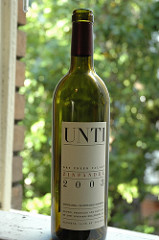WTN: 2003 Unti Zinfandel, Dry Creek Valley

Photo by Melissa Schneider.
Critics, for the most part, bemoan the steady increase in alcohol levels in wine. As the alcohol goes up, the drink's ability to pair with food goes down.
Zinfandel is the worst offender. Three years ago, getting close to 15% alcohol was considered unusual. Today, 16 is the new 15. Producers get higher sugar concentrations by letting the grapes hang. Consumers get a wine that lumbers over the palate. To offer some perspective, port, which you make by adding brandy to wine, usually hovers in the 18-20% range. A fine German Riesling, even a dry one, rarely goes over 12.5%.
So the 2003 Unti Dry Creek Zinfandel seemed relatively ethereal with its 14.5% alcohol. It had weight, of course, but you didn't feel like you were swishing syrup in your mouth. And the medium long finish only became hot at the very end. The "low" alcohol was only one food-friendly variable: High acidity and modest tannins refreshed the palate, getting it ready for the next bite of, in our case, duck legs braised in red wine. The wine was well balanced, but not very complex—a pleasantly drinkable wine that should pair well with heavier meats. The dominant aroma was blackberry jam, and there was something else, something musky, that I couldn't quite pin down, along with a hint of bramble.
Unti is a small family-owned winery in the Dry Creek Valley, an appellation known for its Zinfandel. This particular bottle is a blend of Zinfandel, Petit Sirah, and Barbera, from three different vineyards. It retails for about $22, which is a bit too high to make it our new house red, but isn't too unreasonable. I'd buy it just to support producers who keep the alcohol on the low end of the spectrum.
- Whence High Alcohol
Clark Smith, the head of Vinovation, has an Appellation America article about high alcohol levels in California wine. He looks at the complex array of factors that have led us to a world where every California wine has more than 14% alcohol. I see he’s...
- Wtn: 2002 Seghesio "old Vines Zinfandel", Sonoma County
There's no official definition for the term "old vines" or its many variants. This often surprises beginning wine enthusiasts, who see the term frequently in their local wine stores. It could mean that the vines are 100 years old, it could mean they're...
- Wtn: 2001 Syrah, Paschal Winery, Rogue Valley
2001 Syrah, Paschal, Rogue Valley - $23 Every couple years Melissa and I drive to the tiny town of Ashland in southern Oregon to take in some plays with our friends Pavel and Kathleen. Theater is the focus, but now that I'm into wine, I make a habit...
- Imbb 4: California Risotto
Pim's suggestion of a rice dish for "Is My Blog Burning?"'s fourth incarnation coincided nicely with the latest issue of Art Culinaire. Among their many scrumptious recipes, they have an idea for risotto wrapped in prosciutto. Yum. Risotto...
- Visting Ridge
As we drive through the gates of Ridge Vineyard's main tasting room, it is easy to see how the winery got its name. We are at the very top of a mountain in the Santa Cruz Mountain Range, technically in Cupertino, but far removed from the flatlands around...
